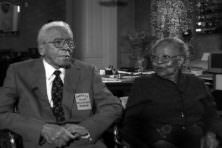THE Farm: A Living Museum of Rural America
- Share
- Tweet
- Pin
- Share

I first went to THE Farm in 2003 or 2004, having avoided it for many years; I had ignorantly assumed it was some sort of hokey petting zoo for kids, and I hadn’t had kids yet. I agreed to go only because my cousin and his young daughter, Scarlett, were in town – THE Farm was her favorite thing about Door County from a previous trip, and she wanted us to go with her for a return visit. So, we went. And we loved it. In the past few years, especially now that we have kids, we visit probably ten times a season.
Carl Scholz, local naturalist, former agriculture teacher and school superintendent, and one of THE Farm’s founders, credits Orville Schopf with the original idea. George Evenson, lifelong farmer, officially designated County of Door historian, and another founder, reiterates, saying, “Orv had been to a place down near Milwaukee on Highway 41 called Old McDonald’s Farm. It was basically a petting zoo, with a few toys for kids, and he thought it was kind of nice.” Carl had visited it, too, and wrote up some ideas as to what a potential Door County venture might encompass.
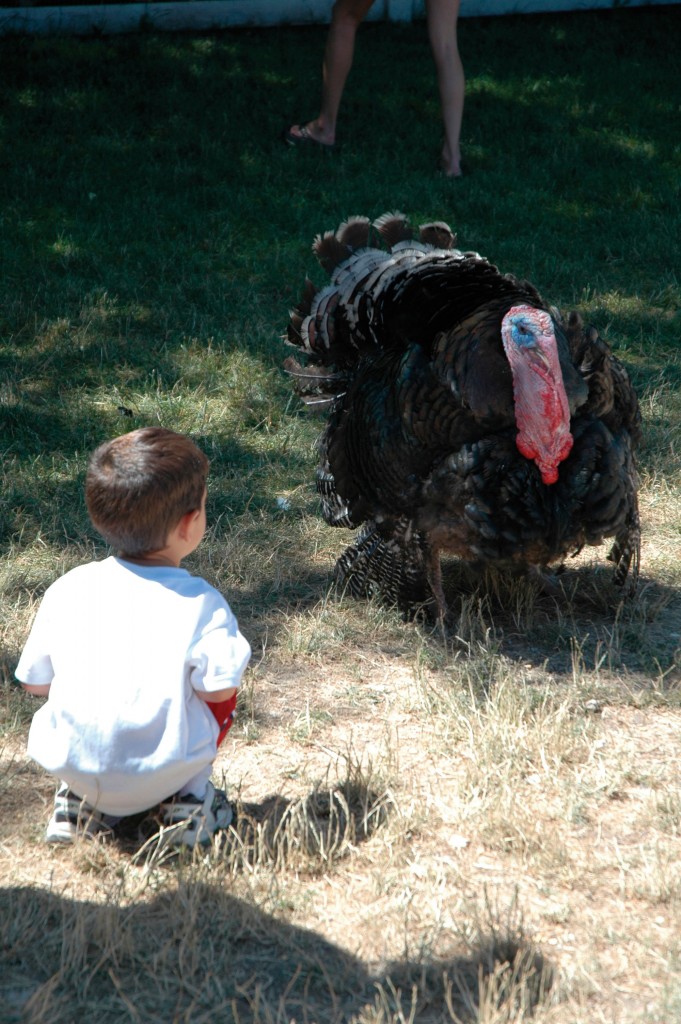
George explains that “at that time, there was a place in Northern Door billing itself as a rural museum – you could see deer, some fish, and watch a chicken play the piano – but it wasn’t doing well, and we thought maybe we could do something that actually paid real tribute to our agricultural heritage.” Carl’s comments match this sentiment, noting that “THE Farm is a living museum, dedicated to preserving rural America and its natural heritage. We tried very hard to focus on and not ever deviate from that mission. THE Farm has really become more significant and important as the years go on, since fewer and fewer farms these days are diverse in their operations – it is more than ever about preserving our history.”

George says he can remember the day in 1964 when he started thinking seriously about the idea “like it was yesterday. We were picking cherries, and Orv stopped by. He convinced me to go to the place near Milwaukee and take a look, so I did. I kind of liked the idea, and thought it would be fun to join Orv, Carl, and Ralph [Roth] on this. Orv, who was a good carpenter, built some models of what it might look like, and we settled pretty quickly on the current site, which was part of the Joseph Zettel estate.” The Zettels said they’d sell it to them, at a price George says was “dirt cheap compared to today. So, we went to Bank of Sturgeon Bay (now Baylake) and told them what we wanted to do, and they said, ‘sure, we’ll back you on that.’” Carl believes the original loan was about $50,000, but each couple also invested $8,000. (Carl is quick to frequently point out that “there were four couples that were partners, not four people – our wives worked just as much and as hard and were just as involved as the men.”) That was enough to cover the purchase of the original 40 acres of land in 1964 or ’65, and construct the first buildings in 1966.
George and Carl both recall it was Orv who designed and oversaw the construction of most of the buildings, starting with the big barn-like structure that did and does serve as entry and gift shop. That was quickly followed by a smaller barn for the animals, a chicken coop, fences, and a log cabin. George says, “The most historic building on the place is that little log building. That was part of the Bassford farm. Bassford was the first Town of Sevastopol settler and a town officer, so there had been a lot of town meetings in that building. [Carl remarks that, in fact, the town itself was formally established in that building.] It was also a post office for a while, too.” During the construction period, they also settled on a name: George says that they decided that “rather than some funny name, let’s just call it THE Farm,” as suggested by Carl. George goes on to explain that “capitalizing all the letters in ‘THE’ was intentional – we wanted the emphasis,” with Carl noting that in the incorporation papers, the letters were not only capitalized, but underlined.
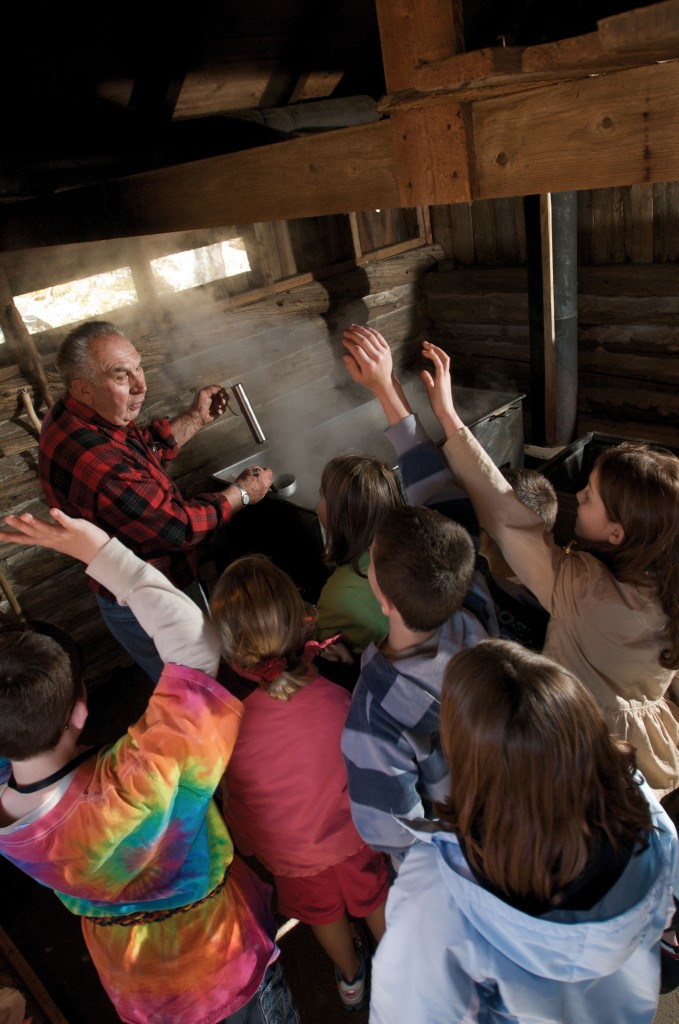
By July 1st of 1966, THE Farm opened for business. George notes, “Those first couple years it was a little slow. None of us had ever been in that kind of business before – we had no idea what kind of volume we’d have. One time, before we opened, we stood by the road and counted the cars going by on a summer day, and we thought, well, we could probably get one in ten of those cars to stop, so we’ll do pretty well. Of course, we didn’t get anywhere near that many! But, it did gradually pick up.” Indeed it did – a rough estimate as to attendance in recent years is in the neighborhood of 50,000 people annually.
Of the handful of years George was a partner in THE Farm, before he got elected to county board and “got too busy,” he recounts, “the four of us and our wives always got along good – we worked well together. It was a lot of fun – those were great years. We’d all look for things to display or sell, bring things back. Orv was in the insurance business – he was a likable guy that knew and met a lot of people, and they just gave him things, so we got quite a collection of farm machinery from all over the country. I think the only real argument we ever had was about soda pop. Carl didn’t think kids should drink soda pop, so we didn’t sell it those first few years. Finally, after so many customers kept asking for it, he gave in.”

Ralph dropped out of the partnership around the same time as George, leaving Orv, Carl, and their wives to run THE Farm. Carl and his wife, Ruth, bought out the Schopfs around 1990, and then sold it around 2001 to David Tanck, his wife Jennifer, and David’s brother Jeff. David explains, “I worked at THE Farm in the ‘80s for six summers during high school and college, and I can honestly say that that was the best job I ever had. I had the pleasure of working for and getting to know Orv before he died, and Carl, and George, although George wasn’t formally involved by the time I started working. All three were forward-thinking men, intelligent and engaging, true historians, knowledgeable about Door County history, and about preservation. I am still amazed at how they came up with the concept, the location, the layout – it’s just idyllic and beautiful and simple. There is nothing like it.”
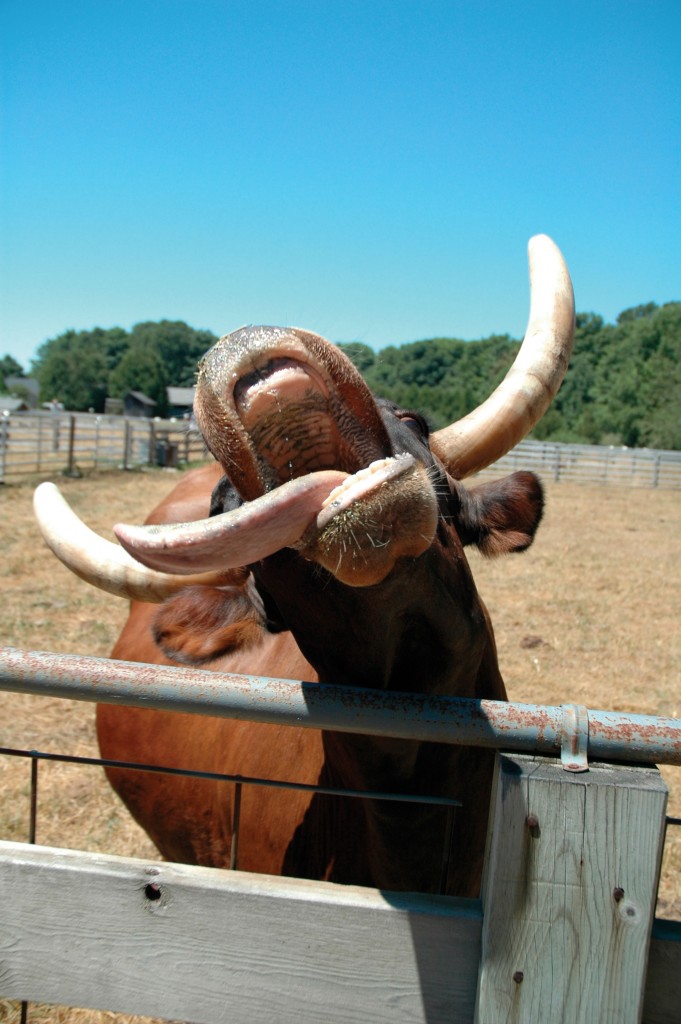
David notes that his parents, Elmer and Shirley, and his brother, Jeff, live in Sturgeon Bay and manage THE Farm and its day-to-day operations. Jeff has a full-time job with Wisconsin Public Service, but David quickly credits him with doing “all the herd management and a lot of the ‘grunt’ work, along with my dad, a plumber and handy man, who can fix anything. I live and work full time in Milwaukee managing nursing homes and retirement communities, so the three of them – with a rather large extended family of aunts and uncles – make THE Farm go. Jennifer and I do as much as we can down here, like payroll and taxes, and I go up at least three of every four weekends during the season to help out as much as I can. Jennifer also helps my mom manage the gift shop inventory and purchasing. For me, one thing that makes THE Farm so special is that I get the chance to work with my family – we all play a part. Carl is still very much involved, too – he plants the gardens and crops for us – we couldn’t have done this without his and Ruth’s continued involvement.”
The founders’ enthusiasm for THE Farm is clearly present in this next generation of owner/operators. David raves, “THE Farm is just the coolest place in the world. I look forward to every season, and the chance to be a part of all of it. We see families come back again and again, throughout the years. We look forward to seeing those children grow up. There are people who have been coming since it opened, bringing multiple generations of their family back with them. I’m honored and blessed – my entire family is – just to be a part of it. Where can you go with your family, that’s very reasonably priced, and really interact with animals, get a hands-on experience, see animals being born? Today’s generation just doesn’t get opportunities like that, to connect with our past.”
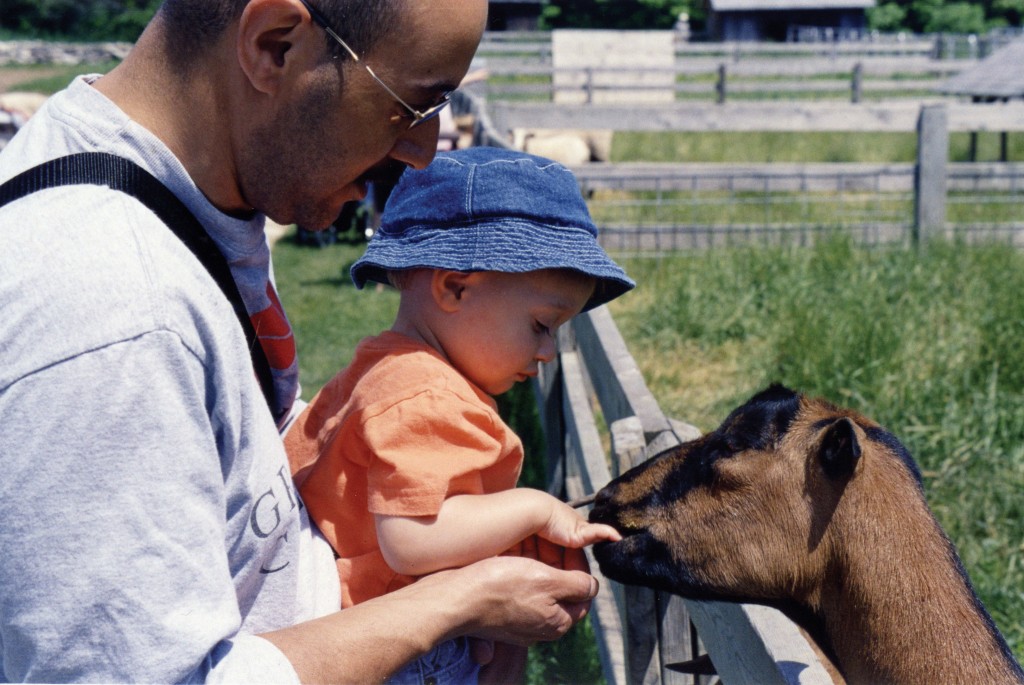
The Grounds
When you first enter the immaculate grounds you are swarmed by friendly baby goats, sheep, and pigs clamoring to be fed from milk bottles. You could easily spend an hour or more just in that first barnyard area, feeding and petting well-cared for goats, sheep, pigs, and cows of all ages, trying your hand at milking a goat, catching baby chicks or kittens (or saving them from the overly affectionate clutches of small children), visiting adult chickens and other fowl, or climbing on the tractor, one of many on display on the grounds.
Outside the main yard, a trail loops down and around a pond with various kinds of ducks and geese, with other trails veering off into quieter, forested areas. There is a large vegetable, crop, and herb garden, and over 20 buildings display old farm equipment, domestic items, tools, information on local flora and fauna, and maple syrup production and beekeeping equipment. Animals to visit or feed are scattered throughout the property, including ponies, horses, donkeys, peacocks, rabbits, pigeons, and doves, and still more sheep, pigs, and goats.
To visit all the animals, exhibits, and trails, you’ll need at least two to three hours. You can still see quite a bit in less time, though – we frequently stop in for a quick visit with our favorite animals.
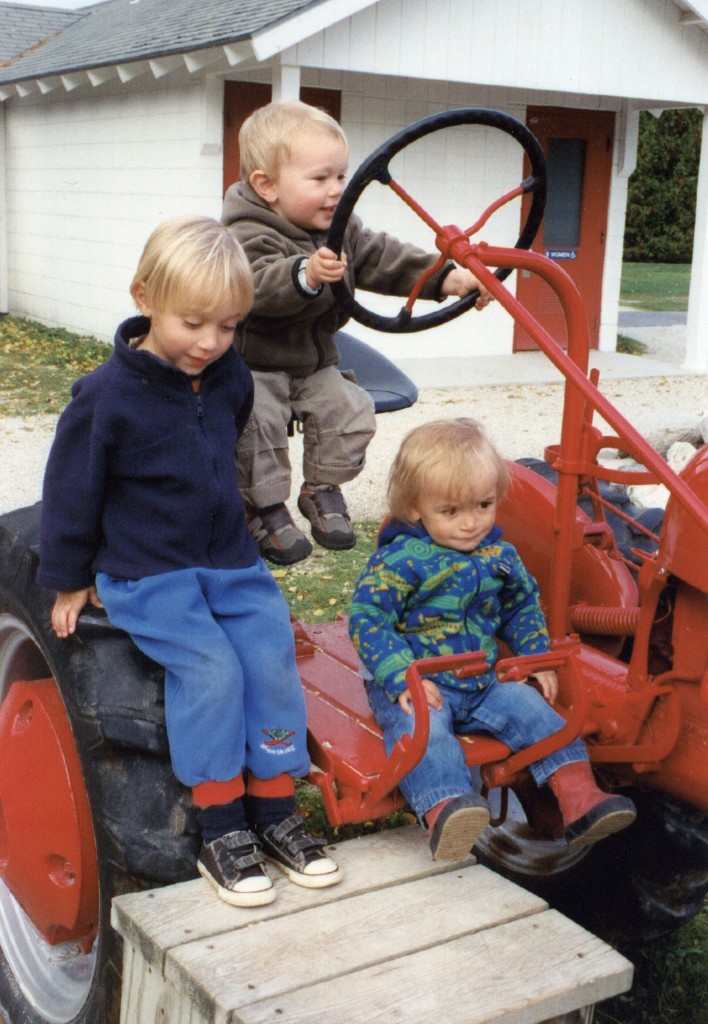
Items such as ice cream bars, chips, water, and soda are sold on the premises, but we like to bring lunch or snacks to supplement – there are many picnic tables located around the property.
Location, Hours, and Other Details
Hours: Open Saturday of Memorial Day weekend through the Sunday after Columbus Day, 9:00 am to 5:00 pm daily.
Address: 4285 State Highway 57 (about a mile after the 42/57 “split” north of the City of Sturgeon Bay)
Phone: (920) 743-6666
Web: www.thefarmindoorcounty.com
Admission: Free for kids under four, $4 for kids ages 4 to 12, $8 for persons 13+. A season pass is double one day’s regular admission fee – thousands of families take advantage of this option each year. You’ll also want milk to feed the baby goats, sheep, and pigs (25 cents per bottle, limit one per person), and corn to feed the other/older animals (25 cents per bag, no limit).
Note: Nearly all paths and exhibit areas are accessible with strollers or wheelchairs, or the many red wagons available to borrow.
Insight From a Local Expert
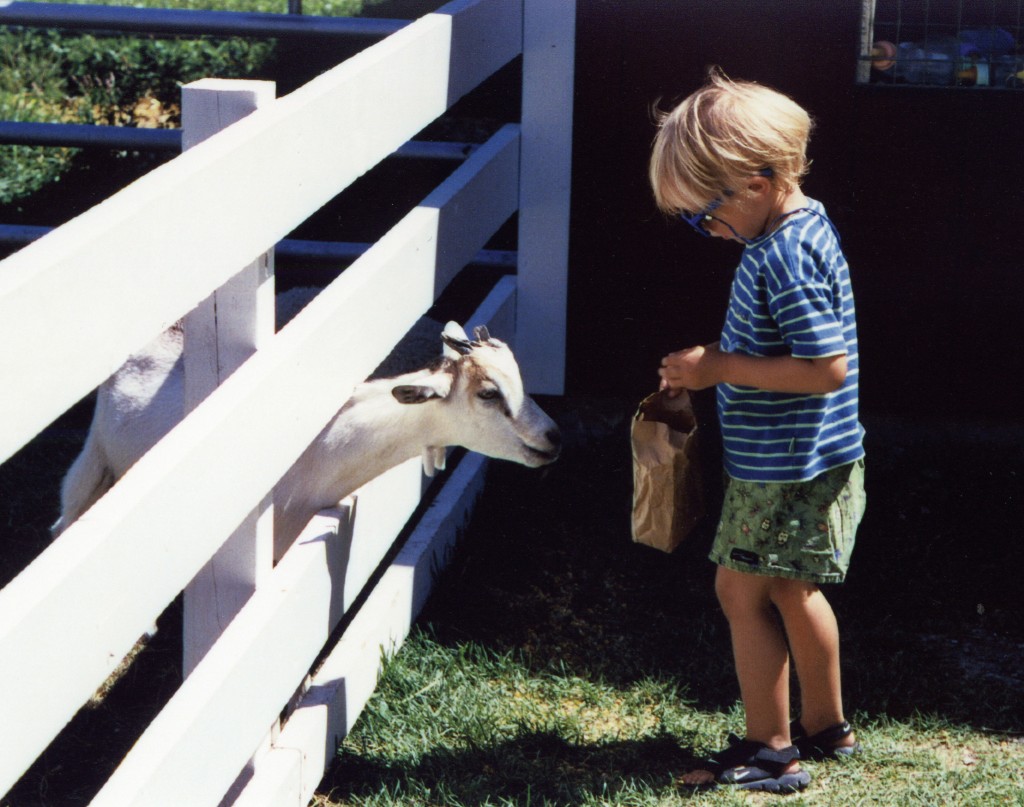
Our oldest son, Theo Goode, is four, and has been to THE Farm at least 30 times. He obligingly consented to an interview.
MG: What is the first thing you like to do when you arrive at THE Farm?
TG: I like to chase the baby chicks and play with the little lambs and pigs.
MG: Tell DCL readers about some of the many different kinds of animals at THE Farm.
TG: Well, Mama, I’m not going to name all the animals. I’m just going to say what they do. Why does a horse run so much faster than I do? Why do the sheep say, “baa”? Why do cows walk so slow?
MG: Which animals are your favorites to visit?
TG: Horsies. Cows – I love Cinnamon and the furry cow. [Cinnamon is a Brahman cow, the first type domesticated by humans, and “the furry cow” is a Scotch Highlander, the first beef animal domesticated by humans.]
MG: Which animals do you most enjoy feeding?
TG: Milk to the baby pigs; once, when Daddy and I went to THE Farm, we saw a pig that had just been born, and he was SO HUNGRY. Corn to the cows.
MG: What are your favorite things to do or see at THE Farm?
TG: Milking the goats. The tractors!
MG: Is there anything else you want to say about THE Farm?
TG: Why isn’t THE Farm always open?


